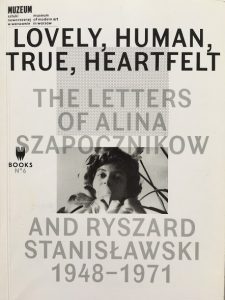 Alina Szapocznikow was born in 1926 into a Jewish family in Poland. In the early period of her life she faced significant trauma and persecution. In 1940, during the German occupation of Poland, she was imprisoned in the Ghetto of Łódź and later in Pabianice. During this time, from the age of fourteen to seventeen, she worked as a nurse alongside her mother. From 1943, she was placed in various concentration camps. By the end of the war she had survived three camps: Auschwitz, Bergen-Belsen and Therezin.
Alina Szapocznikow was born in 1926 into a Jewish family in Poland. In the early period of her life she faced significant trauma and persecution. In 1940, during the German occupation of Poland, she was imprisoned in the Ghetto of Łódź and later in Pabianice. During this time, from the age of fourteen to seventeen, she worked as a nurse alongside her mother. From 1943, she was placed in various concentration camps. By the end of the war she had survived three camps: Auschwitz, Bergen-Belsen and Therezin.
Upon liberation, Szapocznikow moved to Paris. It was here, at nineteen years old, that she began her career in sculpture. Throughout her life, she produced art that explored the fragility of the human body. Her work often focused on the feminine bodily experience, especially her own. In works such as Lampe Bouche (1967), where she commodified the female lips into lamps for sale. Discourse on her work often focuses on the traumatic experience she faced as a girl, and her deteriorating body as a woman. In 1951, aged twenty-five, Szapocznikow was diagnosed with tuberculosis. She almost died from the severity of the illness. The impact on her body would follow her for the rest of her life. As well as severely deliberating her health, it caused her to become infertile.
In 1952, she married her first husband, Ryszard Stanisławski, a Polish art historian. Stanisławski would later become the Director of the Museum of Modern Art in Warsaw. Around the same time, they adopted a son, Piotr Stanisławski. Though they divorced in 1958 they remained close friends. Stanisławski created the extensive Alina Szapocznikow Archive at the Museum of Modern Art in Warsaw. The archive contains a catalogue of documentation relating to her life and work. It includes preserved photographs, correspondence, receipts, sketchbooks, press articles, and her writings, and is now digitised for anyone to explore online. The archive aids in bringing attention to her in art history and serves as a valuable resource of her creative practice.
There are several books utilising their archival materials on Szapocznikow. Lovely, Human, True, Heartfelt: The Letters of Alina Szapocznikow and Ryszard Stanis≈Çawski 1948 ‚Äì 1971, allows readers an insight into the lives of Szapocznikow and her partner. Through letters, you can trace her life from the age of 22 to 45, two years before her death. The book gives readers a chance to break away from the trauma of her life and the dark undertones of her artworks. Each letter provides an understanding of how ‚Äúlovely, human, true [and] heartfelt” Szapocznikow was.
In 1968, Szapocznikow was diagnosed with breast cancer. She spent her entire life being a survivor. She overcame cycles of trauma and grief, whilst raising a family and striving for artistic success. Szapocznikow died in 1973, at the age of 47.
Alina Szapocznikow will be exhibited at The Hepworth Wakefield from November 2017, and will be the first UK retrospective of her work. For more on this fascinating woman, visit the Alina Szapocznikow Archive.
-Áine McKenny
Junior Girl
Girl Museum Inc.
